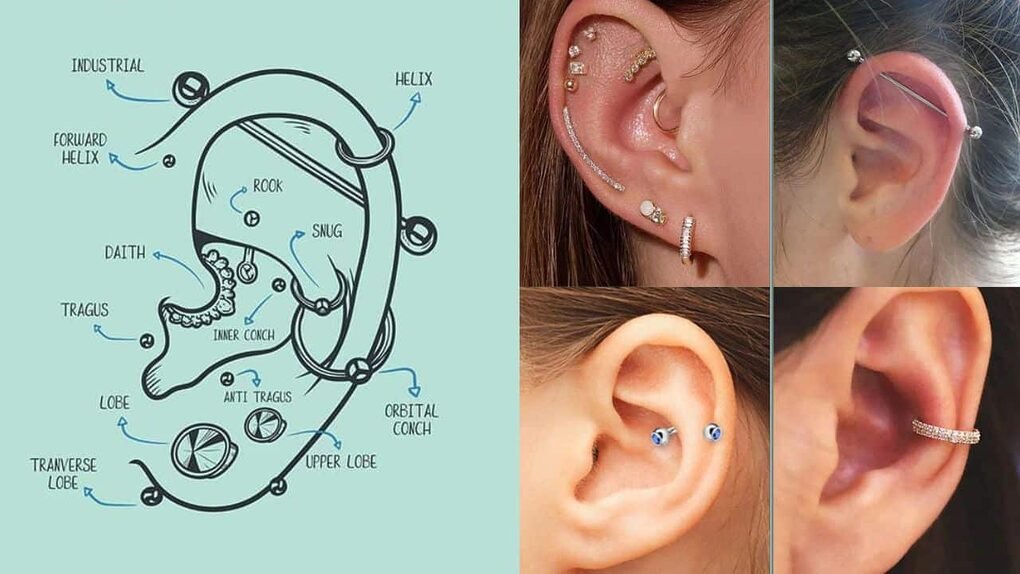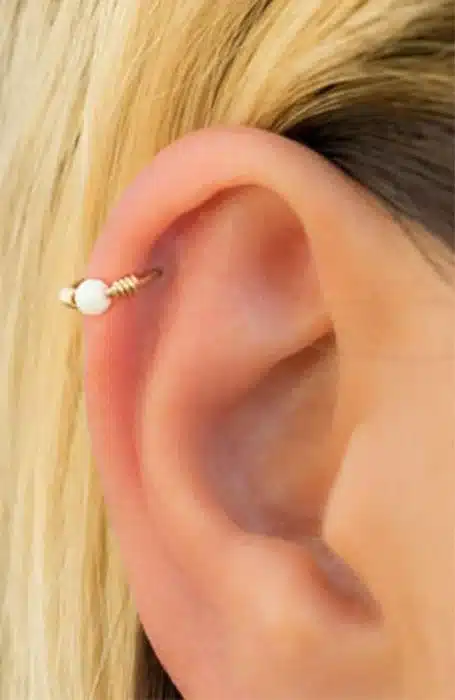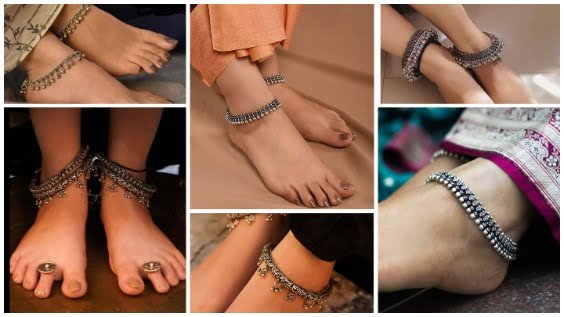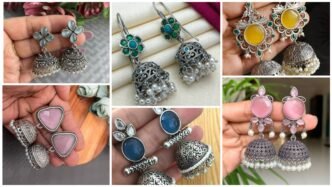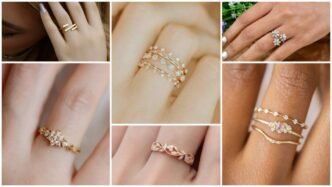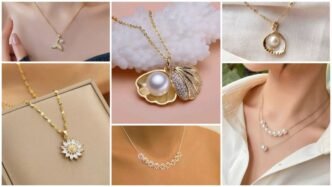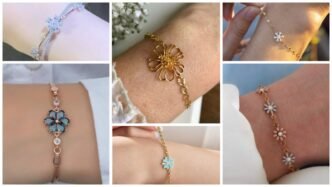Welcome to our comprehensive guide on the ‘Types of Ear Piercings: Best 18 Ear Piercing Chart and Guide’. This blog post is designed to be your ultimate reference point for all things related to ear piercings. Our Ear Piercing Chart is a meticulously curated visual guide that showcases 18 unique types of ear piercings, each with its own distinct charm and personality. Whether you’re a piercing enthusiast or a novice just starting your journey, this chart will serve as your roadmap, helping you navigate the fascinating world of ear piercings.
In the following sections, we will delve into a detailed overview of the ear piercing chart. Each piercing type is explained with its unique characteristics, placement on the ear, and aesthetic appeal. From the popular earlobe and helix piercings to the more adventurous daith and industrial piercings, our chart covers a wide spectrum of styles. We aim to provide you with a comprehensive understanding of each type, helping you make an informed decision about which piercing might be the perfect fit for your style and comfort. So, let’s embark on this exciting journey and explore the captivating world of ear piercings together.
18 Types of ear piercings
1. Industrial Piercing
An Industrial Piercing, also known as a scaffold piercing, is a bold and unique style. It involves two piercings on the upper part of the ear cartilage. These two holes are connected with a single straight piece of jewelry, usually a barbell. The placement and angle of the piercings can vary, creating a variety of looks. This piercing is a statement piece and can be a stunning addition to your collection.
PLACEMENT: Upper ear cartilage PAIN LEVEL: 7-8/10 HEALING TIME: 6 – 12 months
2. Cartilage Piercing
A Cartilage Piercing is a versatile option that can be done at multiple spots on the outer rim of your ear. From a single piercing to multiple ones, this style offers a lot of flexibility. You can choose to wear a small stud, a hoop, or even a cuff depending on your preference. 
PLACEMENT: Outer rim of the ear PAIN LEVEL: 4-6/10 HEALING TIME: 3 – 6 months
3. Daith Piercing
The Daith Piercing is a piercing through the innermost cartilage fold of the ear, right above the ear canal. It’s a subtle yet striking piercing that’s often adorned with a small hoop or heart-shaped jewelry. Some people believe that a daith piercing can help alleviate migraines, although there’s no scientific evidence to support this.
PLACEMENT: Innermost cartilage fold of the ear PAIN LEVEL: 6-7/10 HEALING TIME: 4 – 6 months
4. Tragus Piercing
The Tragus Piercing is located on the small pointed eminence of the outer ear, located in front of the concha. It’s a popular choice for those looking for something a bit different. A small stud or hoop fits perfectly in this spot, adding a subtle touch of style.
PLACEMENT: Small pointed eminence of the outer ear PAIN LEVEL: 5-6/10 HEALING TIME: 3 – 6 months
5. Orbital Piercing
The Orbital Piercing involves two holes in the ear cartilage or earlobe. These are connected by one piece of jewelry, usually a ring. This piercing can be placed in various locations on the ear, making it a versatile choice. It’s a unique and eye-catching style that’s sure to stand out.
PLACEMENT: Ear cartilage or earlobe PAIN LEVEL: 6-7/10 HEALING TIME: 4 – 6 months
6. Antitragus Piercing
The Antitragus Piercing is located above the earlobe and opposite the tragus. It’s a less common piercing that can add an edgy touch to your look. This area of the ear is thicker, so the piercing process may be slightly more intense. PLACEMENT: Above the earlobe and opposite the tragus
PAIN LEVEL: 6-7/10 HEALING TIME: 3 – 6 months
7. Rook Piercing
The Rook Piercing is a piercing of the antihelix of the ear, located above the tragus. It’s a stylish and unique piercing that stands out. This piercing is typically adorned with a curved barbell or a small hoop.
PLACEMENT: Antihelix of the ear PAIN LEVEL: 6-7/10 HEALING TIME: 4 – 6 months
8. Ear Lobe Piercing
The Ear Lobe Piercing is the most common type of ear piercing. It’s a great choice for first-timers due to the lower pain level and quicker healing time. You can choose to wear a variety of jewelry types in this piercing, from studs to hoops.
PLACEMENT: Earlobe PAIN LEVEL: 2-3/10 HEALING TIME: 6 – 8 weeks
9. Helix Piercing
The Helix Piercing is a piercing of the upper ear cartilage. It’s a popular choice for those looking to venture beyond the traditional earlobe piercing. A small hoop or stud fits perfectly in this spot.
PLACEMENT: Upper ear cartilage PAIN LEVEL: 5-6/10 HEALING TIME: 3 – 6 months
10. Forward Helix Piercing
The Forward Helix Piercing is a piercing at the front of the cartilage. It’s a subtle yet stylish piercing that’s often adorned with a small stud or hoop.
PLACEMENT: Front of the cartilage PAIN LEVEL: 6-7/10 HEALING TIME: 3 – 6 months
11. Snug Piercing
The Snug Piercing, also known as the anti-helix piercing, is located on the inner rim of the ear cartilage. It’s a unique and less common piercing that can add an interesting element to your ear jewelry. This piercing is typically adorned with a small curved barbell or hoop.
PLACEMENT: Inner rim of the ear cartilage PAIN LEVEL: 7-8/10 HEALING TIME: 6 – 12 months
12. Transverse Lobe Piercing
The Transverse Lobe Piercing is a horizontal piercing that goes through the earlobe. Unlike a traditional lobe piercing, the jewelry in a transverse lobe piercing lies horizontally across the lobe rather than hanging down. This piercing is typically adorned with a barbell.
PLACEMENT: Horizontal through the earlobe PAIN LEVEL: 3-4/10 HEALING TIME: 2 – 3 months
13. Conch Piercing
The Conch Piercing is a piercing of the middle part of the ear, in the largest section of the ear cartilage. It’s named after the conch shell because of its similar shape. This piercing can be adorned with a hoop or a stud, depending on your preference.
PLACEMENT: Middle part of the ear PAIN LEVEL: 6-7/10 HEALING TIME: 3 – 6 months
14. Top Ear Piercing
The Top Ear Piercing is a style where the upper part of the ear is pierced. It’s a versatile piercing that can be adorned with a variety of jewelry types, from studs to hoops or cuffs.
PLACEMENT: Upper part of the ear PAIN LEVEL: 5-6/10 HEALING TIME: 3 – 6 months
15. 3 Ear Piercings
The 3 Ear Piercings style involves three piercings done on the ear. The placement of these piercings can vary based on your preference, but a common arrangement is one on the lobe and two on the cartilage. This style allows for a lot of creativity in jewelry selection.

PLACEMENT: Varies (commonly one on the lobe and two on the cartilage) PAIN LEVEL: Varies based on placement HEALING TIME: 2 – 12 months, depending on the placement
16. Double Ear Piercing
The Double Ear Piercing is a style where two piercings are done on the earlobe. This is a classic and popular choice that allows for a variety of jewelry combinations. You can choose to wear two studs, two hoops, or mix and match.
PLACEMENT: Earlobe PAIN LEVEL: 2-3/10 HEALING TIME: 6 – 8 weeks
17. Full Ear Piercing
The Full Ear Piercing is a style where the entire ear is pierced. This can involve multiple piercings on the lobe, cartilage, and other parts of the ear. It’s a bold choice that allows for a lot of personalization and creativity.
PLACEMENT: Entire ear PAIN LEVEL: Varies based on the number and placement of piercings HEALING TIME: Varies based on the number and placement of piercings
18. Simple Ear Piercing
The Simple Ear Piercing is a minimalist style of ear piercing. This usually involves a single piercing on the earlobe, although it can also refer to a single piercing anywhere on the ear. It’s a timeless and elegant choice. PLACEMENT: Usually the earlobe, but can be anywhere on the ear
PAIN LEVEL: 2-3/10 for an earlobe piercing, varies for other placements HEALING TIME: 6 – 8 weeks for an earlobe piercing, varies for other placements
Choosing the Right Ear Piercing for You
When it comes to choosing the right ear piercing for you, there are several factors to consider. These include the pain level, healing time, and aesthetics of the piercing. Each of these factors plays a significant role in your overall piercing experience and satisfaction.
01. Pain Level
The pain level of a piercing is subjective and can vary from person to person. However, some piercings are generally considered more painful than others. For instance, piercings that go through more cartilage, like the industrial or daith piercing, are often described as more painful than a simple earlobe piercing. It’s important to remember that the pain is temporary and usually lasts only for the duration of the piercing process.
02. Healing Time
The healing time of a piercing can also vary greatly depending on the type of piercing and your body’s healing process. Generally, piercings through the earlobe heal faster than those through cartilage. For example, an earlobe piercing typically heals within 6-8 weeks, while a cartilage piercing like the helix may take 3-6 months to heal. During the healing process, it’s crucial to follow the aftercare instructions provided by your piercer to avoid infection and ensure a smooth healing process.
03. Aesthetics
The aesthetics of a piercing refer to how the piercing looks on your ear. This can depend on the placement of the piercing, the type of jewelry used, and how the piercing complements your overall look. When considering aesthetics, think about your personal style and how the piercing will fit into that. You might also want to consider your lifestyle and whether a particular piercing might interfere with activities like sports or wearing headphones.
04. Additional Considerations
In addition to pain level, healing time, and aesthetics, there are a few other factors you might want to consider when choosing a piercing. One of these is the piercer’s experience and reputation. It’s important to choose a professional piercer who follows all safety and hygiene standards to ensure a safe and successful piercing experience.
Another factor to consider is the cost of the piercing. The cost can vary depending on the type of piercing, the jewelry chosen, and the piercer’s fees. Make sure to budget for the piercing and any aftercare products you’ll need.
Lastly, consider your commitment to the aftercare process. Proper aftercare is crucial to prevent infection and ensure your piercing heals correctly. This can involve cleaning the piercing regularly and avoiding certain activities like swimming or sleeping on the pierced ear.
Choosing the right ear piercing for you is a personal decision that should be based on careful consideration of various factors. By considering the pain level, healing time, aesthetics, and other factors like cost and aftercare commitment, you can choose a piercing that you’ll be happy with for years to come. Remember, the most important thing is that you feel comfortable and confident with your choice.
Aftercare Tips for Different Ear Piercings
Proper aftercare is crucial for the healing process of any piercing. It helps prevent infection and ensures that your piercing heals correctly. Here are some general care guidelines and specific aftercare tips for different types of ear piercings.
General Care Guidelines
The first few weeks after getting a piercing are the most critical for aftercare. During this time, it’s important to keep the area clean and avoid any activities that could irritate the piercing.
- Cleanliness: Clean your piercing with a saline solution twice a day. Avoid using alcohol or hydrogen peroxide as these can dry out the skin and delay healing.
- Avoid Touching: Try to avoid touching your piercing unless you’re cleaning it. Always wash your hands thoroughly before touching your piercing.
- Avoid Swimming: Try to avoid swimming in pools, hot tubs, or open water during the first few weeks after getting your piercing to avoid potential infection.
- Be Careful with Clothing and Hair: Be careful when changing clothes or brushing your hair so you don’t accidentally pull on the jewelry.
- Healthy Lifestyle: Maintain a healthy lifestyle. Good nutrition and adequate sleep can help your body heal faster.
Specific Aftercare for Different Types of Piercings
Different types of piercings may require slightly different aftercare procedures. Here are some tips for specific types of ear piercings:
- Earlobe Piercing: Earlobe piercings are usually the easiest to care for. Follow the general care guidelines and be sure to rotate the earrings a few times a day to prevent the skin from adhering to the jewelry.
- Cartilage Piercing: Cartilage piercings require a bit more care as they’re more prone to infection. Avoid sleeping on the side of the piercing and try not to put pressure on it.
- Industrial Piercing: Industrial piercings require careful cleaning because they involve two separate holes. Be sure to clean both sides of the piercing and the jewelry.
- Tragus Piercing: Tragus piercings can be tricky to clean because of their location. Use a cotton swab soaked in saline solution to gently clean the area.
- Daith Piercing: Daith piercings are located in a small, curved area of the ear, which can make them difficult to clean. It might be helpful to use a saline spray to reach the area.
Remember, everyone’s body is different, and healing times can vary. If you notice any signs of infection, such as persistent redness, swelling, or discharge, contact a healthcare professional. Proper aftercare can help ensure that your piercing heals well and looks great for years to come.
In this comprehensive guide, we’ve explored the diverse world of Types of Ear Piercings, providing a detailed chart and guide to help you navigate your piercing journey. From the classic earlobe piercing to the more adventurous industrial piercing, we’ve covered 18 unique types of ear piercings, each with its own distinct charm and personality.
To recap, we’ve delved into the specifics of each piercing type, discussing their placement, pain level, and healing time. We’ve also considered the aesthetics of each piercing, helping you visualize how they might complement your personal style. Furthermore, we’ve highlighted the importance of aftercare in ensuring a smooth healing process and maintaining the health of your piercing.
We encourage you to continue exploring the fascinating world of ear piercings. Remember, choosing the right piercing is a personal journey that should reflect your individuality and style. Whether you’re considering your first piercing or looking to add to your collection, understanding the different types of ear piercings can help you make an informed decision. So, don’t be afraid to experiment and express yourself through your choice of ear piercings. After all, each piercing is not just a piece of jewelry; it’s a statement of who you are.
